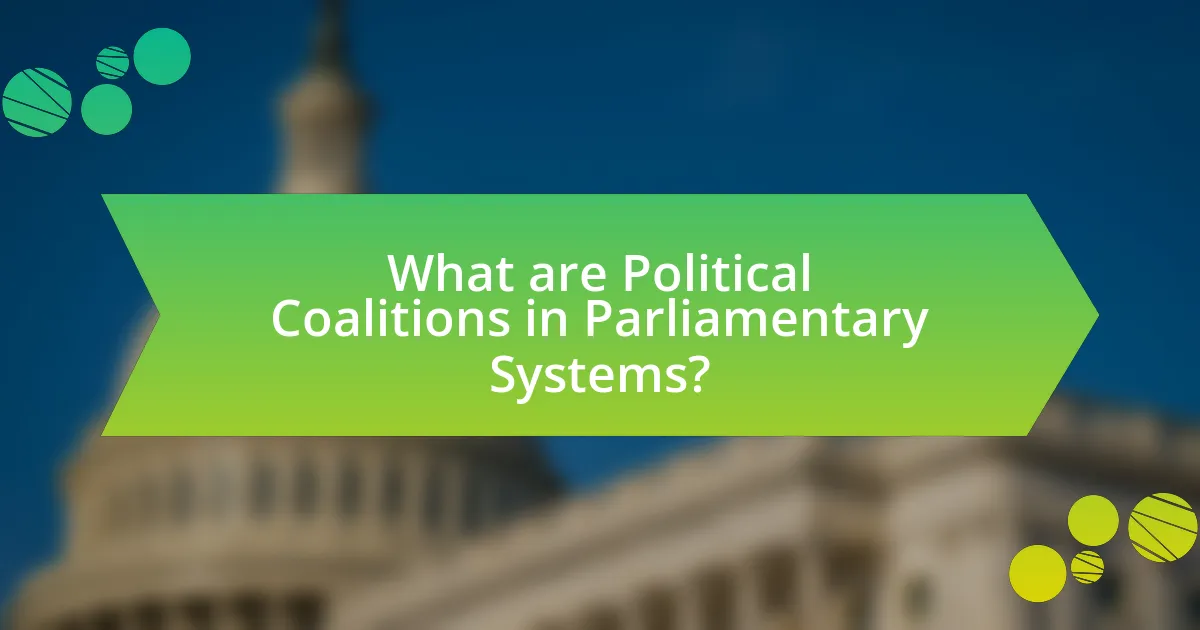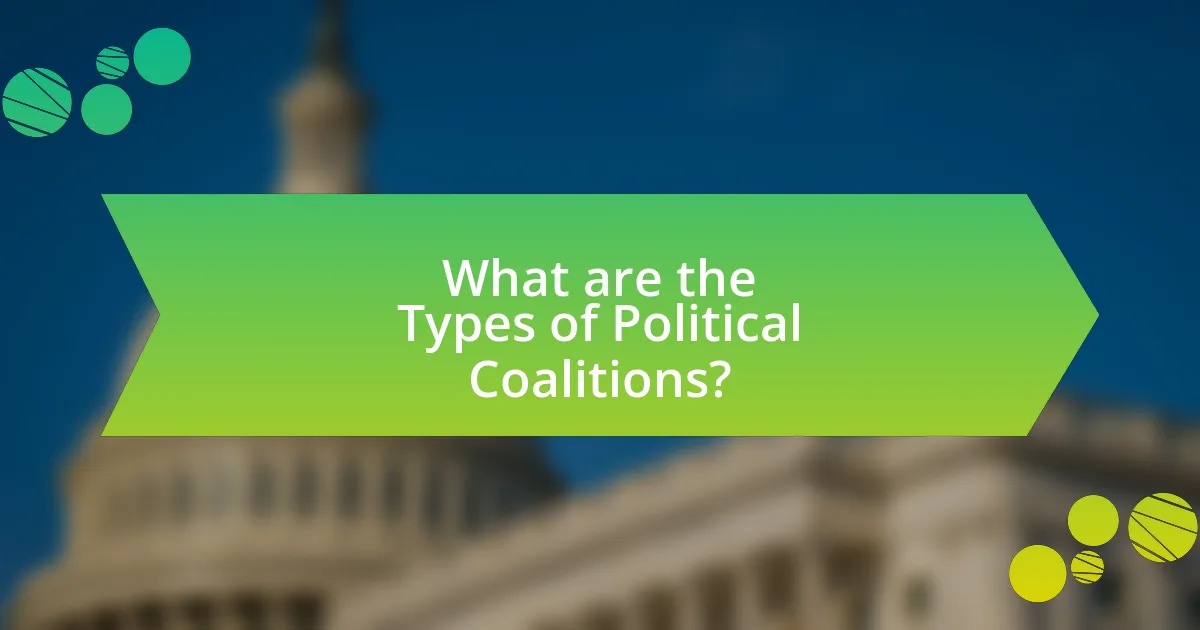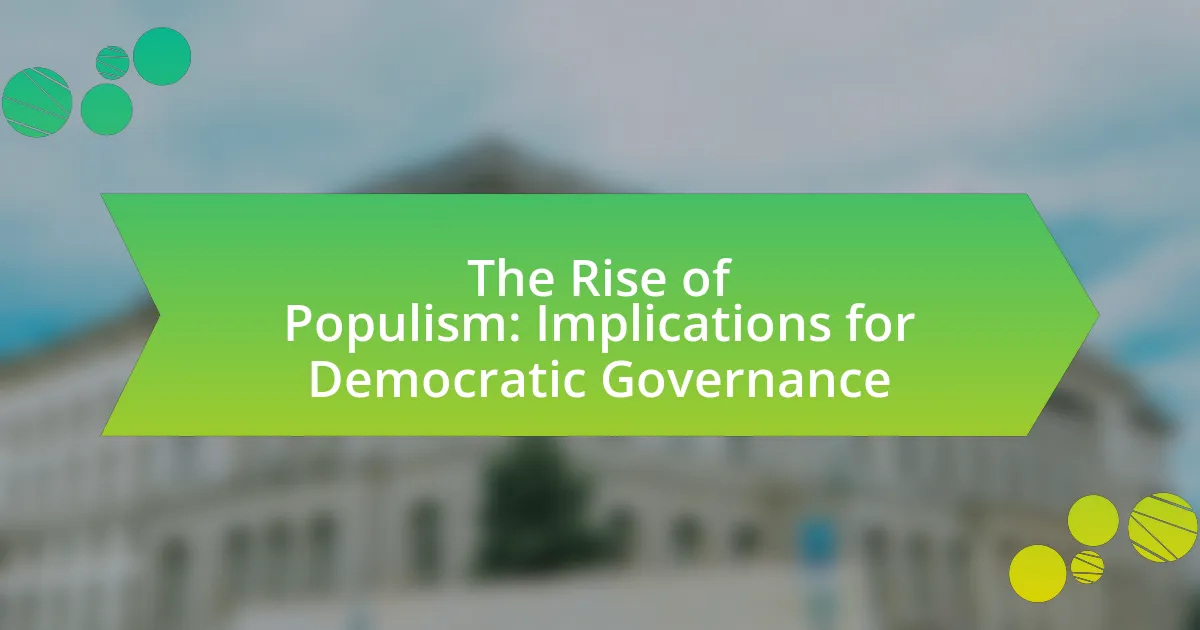Political coalitions in parliamentary systems are alliances formed between political parties to secure a majority in the legislature, essential for effective governance. This article explores the formation, significance, and challenges of political coalitions, highlighting factors such as ideological alignment, electoral systems, and external influences that impact coalition dynamics. It categorizes coalitions into formal, informal, and issue-based types, and discusses strategies for successful coalition management, including communication and negotiation. Additionally, the article examines the role of leadership, public opinion, and economic conditions in shaping coalition stability and performance.

What are Political Coalitions in Parliamentary Systems?
Political coalitions in parliamentary systems are alliances formed between political parties to achieve a majority in the legislature. These coalitions are essential for governance, as they enable parties to combine their seats to secure control over parliamentary decisions and pass legislation. For instance, in many parliamentary democracies, no single party may win an outright majority in elections, necessitating the formation of coalitions to create a stable government. Historical examples include the coalition governments in countries like Germany and Italy, where multiple parties collaborate to form a governing majority, reflecting the diverse political landscape and the need for compromise in policy-making.
How do Political Coalitions form in Parliamentary Systems?
Political coalitions in parliamentary systems form through negotiations among political parties to achieve a majority in the legislature. These coalitions typically arise after elections when no single party secures an outright majority, prompting parties to collaborate to create a stable government. For instance, in the 2017 German federal election, the Social Democratic Party and the Christian Democratic Union engaged in coalition talks to form a government, illustrating how parties negotiate policy agreements and power-sharing arrangements to secure legislative support.
What factors influence the formation of Political Coalitions?
The formation of political coalitions is influenced by several key factors, including ideological alignment, electoral outcomes, and strategic interests. Ideological alignment among parties facilitates cooperation, as parties with similar beliefs are more likely to collaborate effectively. Electoral outcomes, such as the distribution of seats in parliament, determine whether a coalition is necessary for a majority, influencing the willingness of parties to negotiate. Additionally, strategic interests, including the desire for policy influence or access to resources, motivate parties to form coalitions. For example, in the 2017 German federal election, the need for a coalition arose due to no single party achieving a majority, leading to negotiations primarily between the Christian Democratic Union and the Social Democratic Party, showcasing how electoral outcomes directly impact coalition formation.
How do electoral systems impact coalition formation?
Electoral systems significantly influence coalition formation by determining how votes translate into seats in the legislature. In proportional representation systems, smaller parties can gain representation, leading to a higher likelihood of coalition governments, as seen in countries like Sweden and the Netherlands, where multi-party systems are common. Conversely, majoritarian systems, such as those in the United States and the United Kingdom, tend to favor larger parties, often resulting in single-party governments and less frequent coalitions. This dynamic is evidenced by the fact that in the 2019 UK general election, the Conservative Party won a majority, eliminating the need for coalition negotiations. Thus, the structure of the electoral system directly shapes the political landscape and the feasibility of coalition-building.
Why are Political Coalitions important in Parliamentary Systems?
Political coalitions are important in parliamentary systems because they enable the formation of a stable government by bringing together multiple parties to achieve a majority. In many parliamentary systems, no single party often secures an outright majority, necessitating alliances to govern effectively. For instance, in the 2017 German federal election, the Social Democratic Party and the Christian Democratic Union formed a coalition to create a governing majority, illustrating how coalitions facilitate governance and legislative action. Additionally, coalitions allow for a broader representation of diverse political views, enhancing democratic legitimacy and ensuring that various interests are considered in policy-making.
What role do coalitions play in governance and policy-making?
Coalitions play a crucial role in governance and policy-making by enabling diverse political groups to collaborate and form a majority, which is essential for passing legislation in parliamentary systems. This collaboration allows for the representation of a broader range of interests and perspectives, facilitating compromise and negotiation among parties. For instance, in the United Kingdom, coalition governments, such as the one formed in 2010 between the Conservative Party and the Liberal Democrats, demonstrated how coalitions can stabilize governance by pooling resources and expertise to address complex policy issues. Additionally, coalitions often lead to more comprehensive policy outcomes, as they require consensus-building among various stakeholders, which can enhance the legitimacy and acceptance of policies among the electorate.
How do coalitions affect political stability?
Coalitions can enhance political stability by fostering compromise and collaboration among diverse political parties. In parliamentary systems, coalitions often bring together parties with varying ideologies, which can lead to more inclusive governance and broader representation of the electorate. For instance, the coalition government in Germany, formed by the Christian Democratic Union and the Social Democratic Party, has historically contributed to stable governance by balancing interests and preventing extreme policy shifts. Additionally, research indicates that coalition governments tend to be more resilient during crises, as they can pool resources and expertise from multiple parties, thereby maintaining continuity in leadership and policy implementation.

What are the Types of Political Coalitions?
Political coalitions can be categorized into several types, primarily including formal coalitions, informal coalitions, and issue-based coalitions. Formal coalitions are established through official agreements between political parties to work together, often resulting in a coalition government, as seen in countries like Germany and Italy. Informal coalitions arise from mutual agreements without formal contracts, allowing parties to collaborate on specific issues while maintaining independence, which is common in parliamentary systems. Issue-based coalitions focus on specific policies or agendas, bringing together diverse parties to achieve common goals, such as environmental initiatives or social reforms, exemplified by various alliances formed during legislative debates. These classifications highlight the strategic nature of political alliances in parliamentary systems, where collaboration is essential for governance.
What distinguishes formal coalitions from informal alliances?
Formal coalitions are characterized by official agreements and structured arrangements among political parties, while informal alliances are based on mutual understanding and cooperation without formal contracts. Formal coalitions typically involve negotiated terms, shared governance responsibilities, and often require legal documentation, as seen in parliamentary systems where coalition agreements outline policy priorities and cabinet positions. In contrast, informal alliances may lack such binding agreements and can be more fluid, relying on trust and shared interests, which can lead to instability or changes in collaboration without formal processes.
How do formal coalitions operate within parliamentary frameworks?
Formal coalitions operate within parliamentary frameworks by uniting multiple political parties to achieve a majority for governance. These coalitions are formed through negotiations where parties agree on shared policies and leadership roles, enabling them to collectively control the legislative agenda. For instance, in the United Kingdom, coalition governments have historically emerged when no single party secures an outright majority, as seen in the 2010 coalition between the Conservative Party and the Liberal Democrats. This collaboration allows for more stable governance and the ability to pass legislation that reflects a broader spectrum of political interests, thereby enhancing democratic representation.
What are the characteristics of informal alliances?
Informal alliances are characterized by flexibility, lack of formal agreements, and a focus on shared interests among parties. These alliances often emerge in parliamentary systems to facilitate cooperation without the constraints of formal coalitions, allowing parties to adapt quickly to changing political landscapes. The absence of binding contracts enables members to negotiate terms based on immediate needs, fostering collaboration on specific issues while maintaining independence. This dynamic can lead to strategic partnerships that enhance legislative effectiveness, as evidenced by various instances in parliamentary history where parties have successfully collaborated informally to pass key legislation.
What are the common strategies used in coalition-building?
Common strategies used in coalition-building include negotiation, compromise, and the establishment of shared goals among diverse political entities. Negotiation involves discussions to align interests and resolve differences, while compromise requires parties to make concessions to achieve a mutually acceptable agreement. Establishing shared goals helps unify coalition members around common objectives, enhancing cooperation. These strategies are essential for forming stable coalitions, as evidenced by successful parliamentary coalitions that have effectively navigated complex political landscapes to achieve legislative success.
How do parties negotiate terms and conditions in coalitions?
Parties negotiate terms and conditions in coalitions through a structured process of dialogue and compromise. This negotiation typically involves discussions on policy priorities, distribution of ministerial positions, and allocation of resources. For instance, in the formation of the German coalition government in 2021, parties engaged in extensive negotiations over climate policy and economic recovery measures, reflecting their respective electoral mandates. The outcome of these negotiations is often formalized in a coalition agreement, which outlines the agreed-upon policies and responsibilities, ensuring that all parties have a clear understanding of their commitments and expectations.
What compromises are typically made during coalition agreements?
Compromises in coalition agreements typically involve policy concessions, power-sharing arrangements, and the allocation of ministerial positions among coalition partners. Political parties often negotiate to align their platforms, which may require them to adjust their stances on key issues such as taxation, healthcare, and social policies to achieve a unified agenda. For instance, in the 2017 German federal elections, the Social Democratic Party agreed to support a more conservative stance on immigration in exchange for increased social spending commitments from the Christian Democratic Union. This illustrates how parties prioritize certain issues over others to form a stable government, reflecting the necessity of compromise in parliamentary systems.

What Challenges do Political Coalitions Face?
Political coalitions face several challenges, including ideological differences, power-sharing disputes, and maintaining unity among diverse member parties. Ideological differences can lead to conflicts over policy decisions, as coalition partners may have varying priorities and beliefs. Power-sharing disputes often arise regarding cabinet positions and resource allocation, which can create tensions and dissatisfaction among coalition members. Additionally, maintaining unity is crucial, as external pressures and internal disagreements can threaten the coalition’s stability, potentially leading to its dissolution. Historical examples, such as the Italian coalition governments, illustrate how these challenges can result in frequent changes in leadership and policy direction, highlighting the complexities inherent in coalition governance.
What internal conflicts can arise within coalitions?
Internal conflicts within coalitions can arise from ideological differences, power struggles, and conflicting interests among member parties. Ideological differences may lead to disagreements on policy priorities, as parties may have divergent views on key issues such as taxation or social welfare. Power struggles can emerge when parties vie for leadership positions or influence over decision-making processes, often resulting in tensions and rivalries. Additionally, conflicting interests may surface when coalition members have different electoral bases or constituency demands, leading to challenges in reaching consensus on legislation. These internal conflicts can hinder the coalition’s effectiveness and stability, as evidenced by historical examples such as the Italian coalition governments, which frequently faced breakdowns due to these dynamics.
How do differing party ideologies create challenges?
Differing party ideologies create challenges by leading to conflicts in policy priorities and governance strategies within parliamentary systems. When parties with contrasting beliefs, such as conservative versus progressive ideologies, attempt to form coalitions, they often struggle to find common ground on key issues like taxation, social welfare, and environmental regulations. This ideological divide can result in gridlock, where legislative progress is stalled due to disagreements, as seen in the coalition government of Germany from 2013 to 2021, where the CDU and SPD faced significant hurdles in reconciling their differing approaches to economic policy and social issues. Such challenges can undermine the effectiveness of governance and lead to public dissatisfaction with political institutions.
What role does leadership play in coalition dynamics?
Leadership is crucial in coalition dynamics as it shapes decision-making, fosters collaboration, and influences the stability of the coalition. Effective leaders facilitate communication among diverse parties, align interests, and negotiate compromises, which are essential for maintaining unity. For instance, in the 2010 UK coalition government, Prime Minister David Cameron’s leadership was pivotal in managing the relationship with the Liberal Democrats, ensuring policy agreements and coalition longevity. This demonstrates that strong leadership can enhance coalition effectiveness and resilience in parliamentary systems.
How do external factors influence coalition stability?
External factors significantly influence coalition stability by affecting the political environment in which coalitions operate. Factors such as economic conditions, public opinion, and international relations can create pressures that either strengthen or weaken coalitions. For instance, during economic downturns, public dissatisfaction may lead to increased scrutiny of coalition partners, potentially destabilizing the alliance. Historical examples, such as the collapse of the Italian government in 2011, illustrate how external economic pressures can lead to the dissolution of coalitions when partners fail to agree on necessary reforms. Additionally, shifts in international relations, such as changes in foreign policy or trade agreements, can also impact coalition dynamics by altering the priorities and alliances of coalition members.
What impact do public opinion and media coverage have on coalitions?
Public opinion and media coverage significantly influence coalitions by shaping public perceptions and political narratives. When public opinion is favorable towards a coalition, it can enhance its legitimacy and stability, as seen in the 2010 UK coalition government, where positive media coverage bolstered public support. Conversely, negative media portrayals can undermine coalition unity and public trust, leading to instability, as evidenced by the 2018 Italian government, which faced challenges due to critical media coverage and fluctuating public sentiment. Thus, the interplay between public opinion and media coverage is crucial in determining the success and longevity of political coalitions.
How do economic conditions affect coalition performance?
Economic conditions significantly influence coalition performance by affecting the stability and effectiveness of governing partnerships. When economic conditions are favorable, such as during periods of growth, coalitions tend to perform better due to increased public support and resources for policy implementation. Conversely, during economic downturns, coalitions often face challenges like reduced public approval and heightened scrutiny, which can lead to instability and potential fragmentation. For instance, research indicates that coalitions in countries experiencing economic crises are more likely to collapse or undergo significant changes, as seen in the 2008 financial crisis, which led to the dissolution of several governments across Europe. Thus, the economic environment serves as a critical determinant of coalition dynamics and their overall success.
What are the best practices for successful coalition management?
Successful coalition management involves clear communication, shared goals, and mutual respect among coalition partners. Establishing open lines of communication ensures that all members are informed and engaged, which fosters trust and collaboration. Defining shared goals aligns the coalition’s efforts and provides a common purpose, enhancing unity and effectiveness. Additionally, cultivating mutual respect among partners encourages a positive working environment, allowing for diverse perspectives to be valued and integrated into decision-making processes. Research indicates that coalitions with strong communication and shared objectives are more likely to achieve their political aims and maintain stability over time.
How can parties effectively communicate within a coalition?
Parties can effectively communicate within a coalition by establishing clear communication channels and regular meetings. Clear channels, such as designated representatives or committees, facilitate the flow of information and ensure that all parties are informed about coalition activities and decisions. Regular meetings, whether in-person or virtual, allow coalition members to discuss issues, negotiate positions, and build consensus. Research indicates that coalitions with structured communication processes are more likely to achieve their objectives and maintain stability, as evidenced by the successful collaboration of parties in the German Bundestag, where regular coordination meetings have led to effective policy-making.
What strategies can be employed to maintain coalition unity?
To maintain coalition unity, regular communication and negotiation among coalition partners are essential. This strategy fosters transparency and trust, allowing parties to address grievances and align their goals. Historical examples, such as the German coalition governments, demonstrate that consistent dialogue helps mitigate conflicts and reinforces collaboration. Additionally, establishing clear agreements on policy priorities and decision-making processes can further solidify unity, as seen in the successful coalitions in Scandinavian countries, where shared objectives have led to stable governance.






